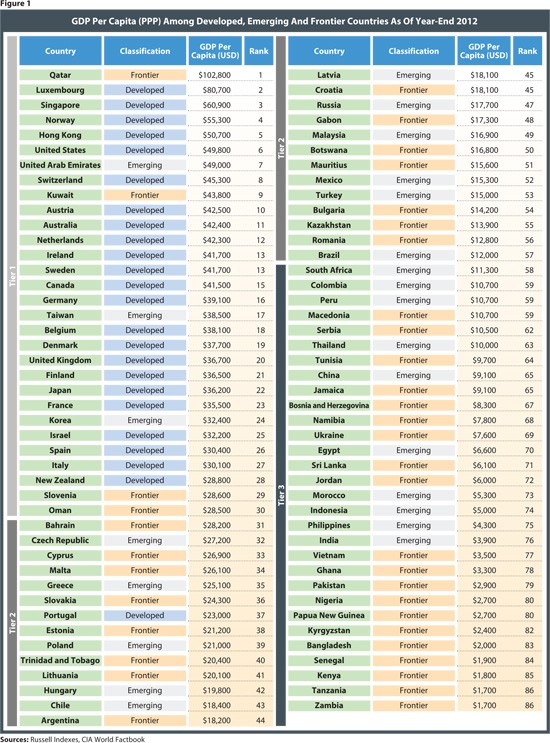Currency Risk of Frontier Market ETFs Low Volume Risk in Emerging Market ETFs
Post on: 30 Апрель, 2015 No Comment

Emerging markets in the BRIC (Brazil, Russia, India and China) may be capable of surviving worldwide jockeying for currency positioning. It is the Frontier Market ETFs like Turkey (TUR), Vietnam (VNM) and Africa (AFK) that have the most to gain AND the most to lose .
Right now, the U.S. dollar carry trade has a fairly straight-forward effect on frontier market ETFs. Dollar down. TUR and VNM up. Dollar up. TUR and VNM down.
Look no further than the dollar devaluation on 11/16 and then. the dollar gains on the following day. Indeed, with the PowerShares Bullish Fund (UUP) surging on 11/17, TUR and VNM were two of the hardest hit ETFs on the trading books.
Unfortunately, there will come a point in time where the dollar carry trade won’t play a role in frontier market investing. The reason? Frontier regions are unlikely to succeed in exporting anything if their respective currencies strengthen too much against the U.S. dollar. Indeed, there’ll come a time when a falling dollar will hurt, not help, frontier market investing.
In contrast, countries like China and Brazil have growing middle classes. Domestic consumption is on the rise. And their fortunes are not forever tied to exports alone. It follows that the currency volatility is unlikely to stifle emerging market investing altogether.
But on the frontier? If the dollar gets too weak. or if the yuan remains this weak. frontier ETFs may struggle. Similarly, if the dollar strengthens dramatically, the carry trade will unwind, and all of the risk investing that’s gone towards the frontier will be liquidated.
On Vietnam (VNM) and Turkey (TUR). it’s best to stay on your toes. In fact, you my want to consider how these investments have failed to hit 52-week highs in the recent week, whereas Vanguard Emerging Markets (VWO) did hit 52-week highs.
Even though investing internationally is still where it’s at, you may want to consider an ETF’s viability. When the investing public has little interest in a particular exchange-traded vehicle, the company sponsoring the ETF may be forced to close the fund. And while you’re not at risk of losing an entire investment, you may not get an adequate liquidation price for having participated.
The essential issue is thinly traded volume; that is, the difference between the asking price and the bid price may be so wide, it becomes prohibitive to buy or sell.
For example, the S&P 500 SPDR Trust (SPY) trades so many shares at a high enough dollar value, the difference between the bid-ask price is negligible at 0.01%. For the iShares Global Consumer Staples Fund (KXI), maybe that spread is closer to 0.20%. Round-trip, that may cost you 0.40%, or 40 basis points.
Yet, there are dozens upon dozens of funds like E-TRACS Short Platinum ETN (PTD). Ron Rowland at Seeking Alpha noted that the 11/19/09 bid-ask spread was 1.2%, or. 2.4% in expense for the privilege of a round-trip purchase.
Rowland’s criteria are easy to wrap one’s head around. Specifically, if an ETF/ETN has been around for more than 6 months, and if it trades on average less than $100,000, the investment is an expensive menace. (In fact, if you think 2.4% on an ETF is tolerable. try getting out with a 10% spread before the markets hit a volatile collapse and nobody is bidding!)

Ironically, there are many terrific ideas that have yet to catch on. In theory, State Street’s developed international sector funds should have spectacular interest. In practice, however, the bid/ask risk of entering SPDR International Consumer Staples (IPS) or SPDR International Utilities (IPU) may be too great.
The same holds true for several emerging market sector funds that entered the scene 5 1/2 months ago: Emerging Global Shares Energy (EEO) and Emerging Global Shares Metals & Mining (EMT). The former trades $150,000 worth on average whereas the latter trades about $250,000 on average. While this doesn’t meet Rowland’s Deathwatch of $100,000 or less, it is woefully low volume for getting a desirable price execution.
Emerging Global’s Emerging Market Index Composite Fund (EEG) is a bit safer at an average dollar trading volume of $300,000. It combines ten economic sectors into an aggregated fund for broader exposure.
Yet, why would an investor risk investing in EEG with volume at $300,000 when the Vanguard Emerging Market Fund (VWO) has dollar volume of $350,000,000? VWO costs less to buy, costs less to sell and costs less to hold in an annual expense ratio. As for performance since EEG launched on 7/22/09, the returns are nearly indistinguishable.
If you’d like to learn more about ETF investing. then tune into In the Money With Gary Gordon. You can listen to the show LIVE, via podcast or on your iPod .
Disclosure Statement: ETF Expert is a web log (blog) that makes the world of ETFs easier to understand. The content does not represent investment advice, nor are the securities discussed suitable for every investor. Pacific Park Financial, Inc. a Registered Investment Adviser with the SEC, may hold positions in the ETFs, mutual funds and/or index funds mentioned above. Investors who are interested in money management services may visit the Pacific Park Financial, Inc. web site.
You can view Gary’s daily market commentary at www.ETFexpert.com. You can also email him directly at garygordon@mypacificpark.com .














